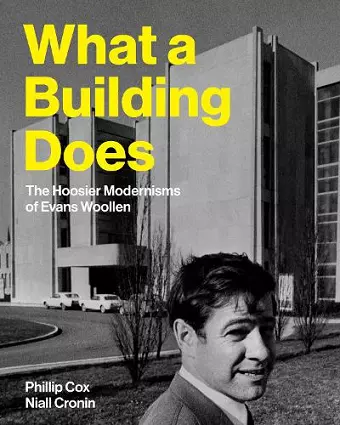What a Building Does
The Hoosier Modernisms of Evans Woollen
Phillip Cox author Niall Cronin author
Format:Hardback
Publisher:Indiana University Press
Published:30th Oct '25
Should be back in stock very soon

Hoosier architect Evans Woollen (1927-2016) made a profound contribution to the built identity of Indianapolis, Indiana. Most recognized for introducing concrete Brutalism to the city, his practice was in fact surprisingly diverse, ranging from significant public buildings that are today some of the city's most iconic structures to humble churches, single-family homes, and historic renovations. Some loved his emphatic, proudly modern buildings, while others found them challenging, severe, or even ugly, but all agreed they were boundary pushing, the handiwork of an iconoclastic architect on the cutting edge of contemporary design.
Surveying the full breadth of Woollen's six-decade career, What a Building Does tells the complete story of this essential Midwestern practitioner for the first time: from his early years as a student of Philip Johnson and Louis Kahn; to his decision to open his practice in Indianapolis; to his later professional successes across Indiana and beyond. With a focus on ten of Woollen's most important built works, this book explores the dynamic ideas which shaped his architecture and the complex relationship he held with Indianapolis, his hometown. Most significantly, it also discovers a multi-decade practice of empathetic, human-centered design conducted long before such ideas were mainstream.
Featuring nearly 150 new full-color photos, never-before-seen archival material, and dozens of interviews with former colleagues, clients, and friends, What a Building Does expands the narrative of modern architecture and its legacy in the American Midwest.
"What a Building Does is the lively and entertaining tale of Evans Woollen - the architect and the man. In telling this story with both words and photographs worthy of Woollen's legacy, Phillip Cox and Niall Cronin manage to give a much needed fresh look at the city of Indianapolis. From lesser known homes to some of the city's most famous landmarks, it shines new light on how Indianapolis became the city it is today." - Matt Shaw, author of American Modern: Architecture, Community, Columbus, Indiana
"Phillip Cox and Niall Cronin's new monograph is a much-needed contribution to the history of post–World War Two American architecture in general and to 'Hoosier Modernism' more specifically." - Michelangelo Sabatino, Illinois Institute of Technology College of Architecture and author of Modern in the Middle: Chicago Houses 1929-1975
"Bold and Brutal. Phillip Cox and Niall Cronin deftly capture the evolution of architect Evans Woollen, portraying the journey from midcentury modernism to experimental postmodernism with whimsy and concrete along the way." - Jordan Ryan, Indianapolis City-County Archivist
"What a Building Does is more than a book - it's a reminder of the enduring power of architecture to provoke thought, foster community, and challenge us to see our surroundings through new eyes. It's a vital addition to the growing dialogue about modernism in the Midwest and a compelling testament to Woollen's legacy as a daring, compassionate architect whose work continues to inspire." - Richard McCoy, Landmark Columbus Foundation
"A fascinating perspective of an architect's journey from pure Miesian modernism of the late 1950's and 60's to situational designs that capture what Evans would call the "spirit and ethos of place". The book captures the variety and excellence of Woollen's significant influence on architecture in Indianapolis, not only through the buildings he designed but also through his impact on the careers of numerous architects who trained in his studio." - Kevin Huse, RATIO Architects; Former CEO of Woollen, Molzan and Partners
"What a Building Does casts the career of Evans Woollen as a master of Modernism into sharper focus, using an array of buildings that differ in function, approach, and time period. . . . It's a historical record that will be useful to planners, preservationists, and those simply curious about why Indiana and Indianapolis look the way they do." - Paul Diebold, Indiana DNR Division of Historic Preservation & Archaeology
ISBN: 9780253074102
Dimensions: unknown
Weight: unknown
246 pages